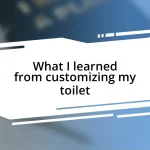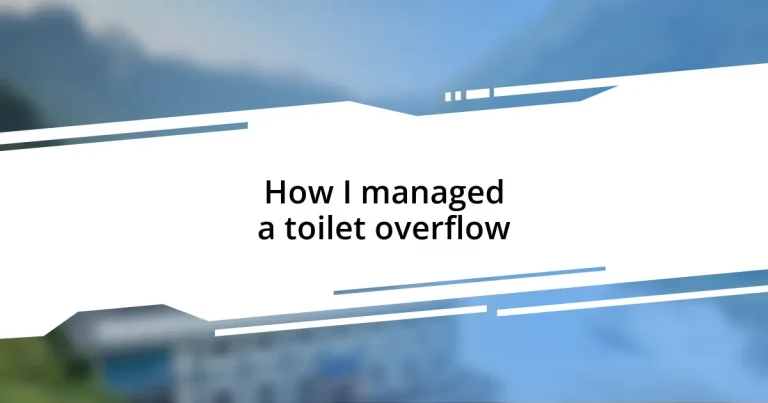Key takeaways:
- Common causes of toilet overflow: clogged drains, faulty valves, and excess water pressure.
- Immediate actions during an overflow: turn off the water supply, remove excess water, and assess the cause.
- Essential tools for fixing an overflow include a plunger, rubber gloves, and a bucket.
- Preventative measures: regular maintenance checks, educating family on flushing rules, and ensuring a proper flow rate.

Understanding toilet overflow causes
Toilet overflow can often be traced back to a few common culprits. One significant cause I’ve encountered is a clogged drain. I remember the panic of watching the water start to rise because my kids decided to treat it like a swimming pool and flush down all their bath toys. It’s important to realize that even small objects can create big problems.
Another factor contributing to overflow might be a faulty valve. I once found myself in a tricky situation when the flapper valve wasn’t sealing properly, allowing water to constantly trickle into the bowl. It’s surprising how something so small can lead to such an overwhelming mess. Have you ever experienced that moment of dread when you realize something as simple as a valve can wreak havoc?
Lastly, excess water pressure can also lead to overflowing toilets. I learned this the hard way during a particularly intense rainstorm; my house’s plumbing system was overwhelmed. It’s crucial to keep an eye on your plumbing pressure, as fluctuations can cause significant issues over time. Understanding these causes not only helps in preventing future incidents but also gives you peace of mind knowing what to look out for.

Immediate steps to take
When faced with a toilet overflow, the first step is to remain calm. I vividly recall the sinking feeling in my stomach when I saw the water beginning to spill over. My instinct was to panic, but it’s essential to pause and think clearly. Quickly shutting off the water supply can prevent a minor mishap from turning into a flood.
Here’s what to do immediately:
- Turn off the water: Locate the shut-off valve near the base of the toilet and turn it clockwise. Just like when I had to stop my kids from splashing around, stopping the water is the first priority.
- Remove excess water: Use towels, rags, or a mop to soak up any spills. I remember how satisfying it felt to have a pile of soaking towels—each one representing a small victory.
- Assess the cause: Whether it’s a clog or a valve issue, try to identify the problem. This is where I learned to investigate calmly instead of just letting emotions take over!
Taking these steps can help you manage the chaos effectively and regain control of the situation.

Tools needed for fixing overflow
Keeping the right tools handy can make all the difference when fixing a toilet overflow. You’ll want to have a plunger ready for those dreaded clogs. I remember the frustration when a simple household item turned into a source of chaos, and the plunger became my best friend. It’s one of those situations where having the right gear at hand can save you from a whole lot of mess.
Another essential tool is a pair of rubber gloves. I never knew the importance of those until I faced a particularly nasty overflow. Slipping my hands into the gloves not only made me feel safer but also gave me the confidence to dive into the problem without worrying about germs. That moment of hesitation vanished, and I could tackle the situation head-on.
Lastly, a bucket is invaluable for capturing any excess water and keeping your workspace clean. I remember using one during an overflow scare, and it quickly became my go-to solution. With water collecting in the bucket instead of spreading across the floor, I felt a sense of control amidst the chaos. Using these simple tools not only makes the repair process manageable but also adds a layer of security when you find yourself in a stressful situation.
| Tool | Purpose |
|---|---|
| Plunger | Clears clogs to prevent overflow |
| Rubber Gloves | Protects hands while handling mess |
| Bucket | Collects excess water during repairs |

Preventative measures for future issues
To prevent future toilet overflow issues, I’ve learned that regular maintenance is crucial. Every month, I check for any signs of wear and tear, especially around the flapper valve. It’s amazing how a little preventive care can save you from the panic and mess of an overflow. Have you ever noticed how easy it is to forget about these small but significant tasks until it’s too late?
In addition to regular checks, I’ve adopted the habit of being mindful about what goes down my toilet. I remember a particularly overwhelming experience when a small toy made its way into the bowl, leading to a miserable afternoon. Now, I take the time to educate my family about the “only flush toilet paper” rule. Establishing this simple guideline can save a lot of headaches—and mess—in the long run.
Another measure I implemented is ensuring that my toilet has a proper flow rate. After experiencing a flood, I researched low-flow models that not only conserve water but also reduce the chances of clogs. Trust me, the peace of mind knowing that the toilet can handle everyday use without problems makes any upgrade worthwhile. Wouldn’t you agree that preventive upgrades can transform a stressful experience into a worry-free routine?

When to call a professional
When dealing with a toilet overflow, there are clear signs that it’s time to call in a professional. If you’ve tried the standard fixes, like plunging or checking for simple clogs, and the situation hasn’t improved, it’s a red flag. I remember feeling utterly overwhelmed when the water wouldn’t stop rising despite my efforts; it was then that I realized that sometimes, you just can’t handle everything on your own.
Another reason to seek professional help is if you notice persistent backflow or water quality issues. It can be alarming to witness the toilet gurgling or see murky water seeping back up. In one instance, a friend experienced this, and they learned the hard way that ignoring this problem can lead to bigger plumbing disasters. Isn’t it better to address the potential for sewage issues sooner rather than later?
Lastly, if you’re unsure about the plumbing system in your house or if the toilet overflow hints at larger issues, it’s prudent to reach out to a plumber. There’s something so freeing about admitting that you need a helping hand, especially when your home’s comfort is at stake. I often think about how a professional can not only resolve the current issue but also provide peace of mind for the future. Isn’t it worth investing in expertise when your home and health are involved?

Long-term maintenance tips
Maintaining your toilet long-term is about forming consistent habits. I remember vividly the time I neglected to tighten the tank’s bolts, which led to a gradual leak. Checking these small yet vital connections regularly can prevent unexpected water puddles, sparing you from that “Uh-oh” moment when you discover a soggy bathroom floor. So, have you set a reminder to keep an eye on these little things?
Another practice I’ve found beneficial is to clean the toilet regularly with quality cleaning products, as this helps prevent mineral buildup and stains. I’ll never forget the relief I felt when I discovered a gel cleaner that worked wonders, transforming my toilet from an eyesore to something I could be proud of. It’s a small investment in time and money that pays you back in cleanliness and functionality. Once you start, you’ll wonder how you ever managed without it!
Lastly, consider keeping a plumber’s contact information handy. I learned this the hard way after a frustrating night battling a peculiar sound coming from my toilet. In hindsight, it would have saved me a lot of stress to have a trusted professional on speed dial during those moments of confusion. Wouldn’t it be comforting to know help is just a phone call away when you need it the most?

Dealing with plumbing emergencies
When a plumbing emergency strikes, such as a toilet overflow, staying calm is essential. I recall my first encounter with a serious overflow; I panicked and splashed water everywhere. In that moment, I learned that taking a breath and assessing the situation could save me from more chaos. So, how do you control your nerves in such situations? I suggest keeping a clear head to avoid making hasty decisions that might complicate the problem.
One of the first steps I take is shutting off the water supply. I had a friend who, in the heat of the moment, forgot this step and ended up with more than a minor mishap. It’s a simple action that can save you from additional damage and stress. Don’t skip it—finding that valve might just become your new best habit!
If you find yourself without a plunger nearby, improvising can be a lifesaver. I’ve used a makeshift device, like an old mop, when in desperation. It wasn’t ideal, but it worked. Relying on creative solutions can not only salvage the situation but also leave you with a sense of accomplishment. Who knew that tackling a plumbing issue could foster resourcefulness?














